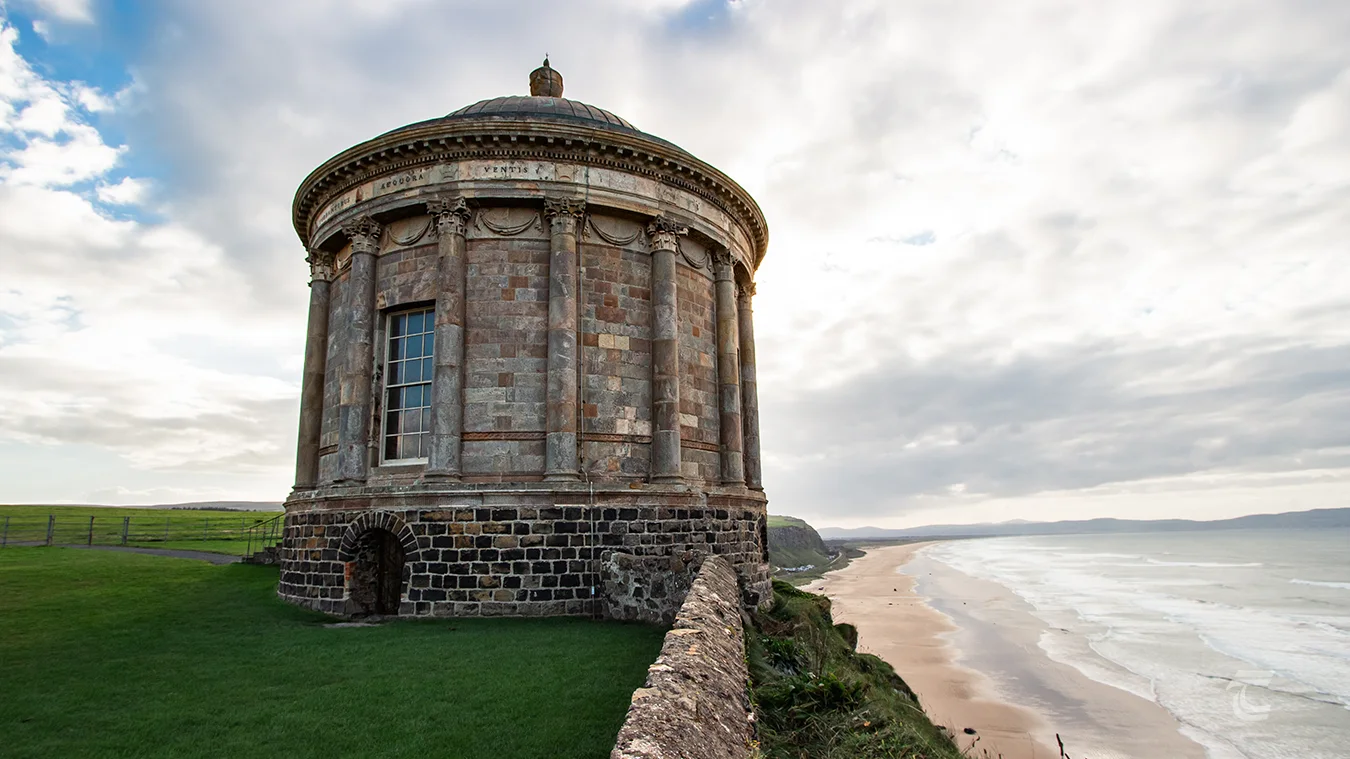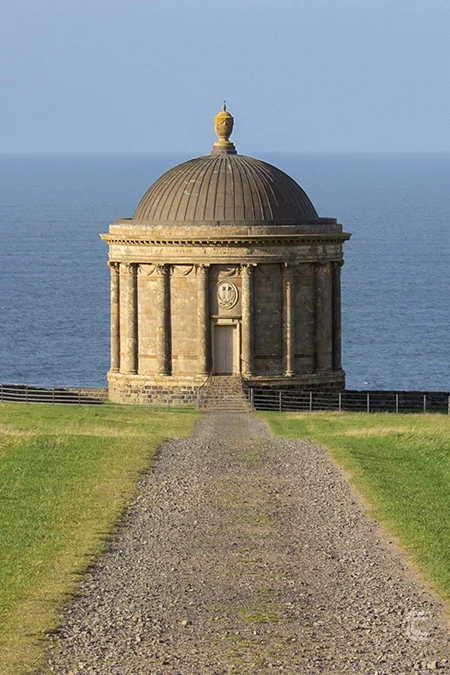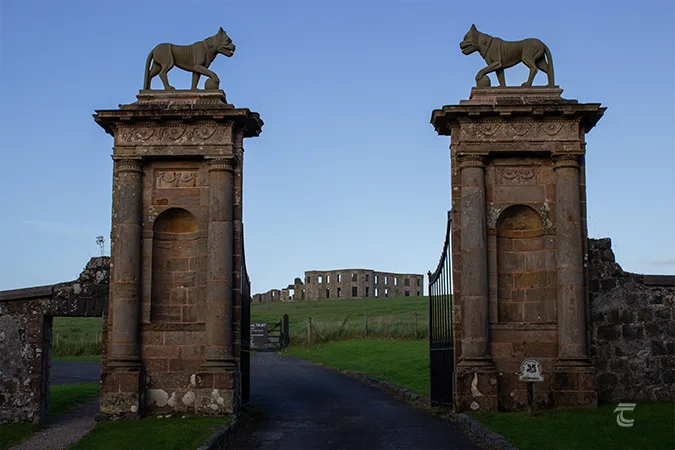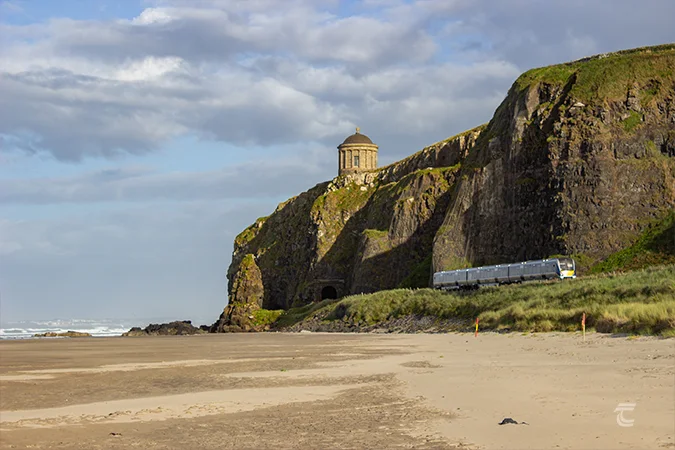Mussenden Temple and Downhill Demesne
The picturesque Mussenden Temple and Downhill Demesne were once the home of the wealthy and flamboyantly eccentric Earl Bishop of Derry, Fredrick Augustus Hervey (1730–1803). Hervey was an ostentatious character, who travelled widely in Italy where he developed a love for the classics, art and geology. He was born in Suffolk, the third son of John Hervey, Baron Hervey of Ickworth. As a third son, he saw his path to prestige through the church, and set about cultivating a career. He was appointed chaplain to King George III, but when his older brother was appointed Lord Lieutenant of Ireland, it opened up new opportunities for the ambitious Frederick. He was not a louche layabout, when first appointed to the bishopric of Cloyne he took his responsibilities seriously, and endeavoured to better the situation both for his diocese as much as for himself. He was promoted to the diocese of Derry by 1768, and he invested large sums available in public improvements. He built a bridge across the River Foyle and restored St Columb’s Cathedral. His efforts were rewarded when he was presented the Freedom of Londonderry in 1770. One of Bishop Hervey’s aims was to better the situation of Catholics, and his attempted method of doing so was to establish an oath of allegiance that Catholics could swear that diluted their allegiance to Rome while strengthening their allegiance to the English Crown. Hervey became the Earl of Bristol on the death of his brother in 1779. This brought him great wealth, and set him on the path to building his grand estate at Downhill Demesne and Mussenden Temple.
He chose the beautifully dramatic headland of Downhill in County Derry to build his grand country house. He spent a fortune on the finest architects and designers, said to include Michael Shanahan, James Wyatt and the noted Italian architect, Placido Columbani. His gallery at Downhill is said to have contained works by Raphael, Murrillo, Titian and Rembrandt. Remarkable evidence for Bishop Hervey’s taste in Classical culture was revealed during works by the Ulster Archaeological Society on behalf of the National Trust. As well as revealing original cobbled surfaces and a number of architectural fragments and features, they discovered a sculptured stone head, which appears to be a Roman portrait dating to AD 161-196, of either the Emperor Marcus Aurelius or his son Commodus. This was likely purchased by the Earl Bishop in Italy, while on one of his grand European tours. It is a tangible reminder of the opulence that once graced the interior of this palace.
For practical information about visiting this site Click Here
The picturesque Mussenden Temple and Downhill Demesne were once the home of the wealthy and flamboyantly eccentric Earl Bishop of Derry, Fredrick Augustus Hervey (1730–1803). Hervey was an ostentatious character, who travelled widely in Italy where he developed a love for the classics, art and geology. He was born in Suffolk, the third son of John Hervey, Baron Hervey of Ickworth. As a third son, he saw his path to prestige through the church, and set about cultivating a career. He was appointed chaplain to King George III, but when his older brother was appointed Lord Lieutenant of Ireland, it opened up new opportunities for the ambitious Frederick. He was not a louche layabout, when first appointed to the bishopric of Cloyne he took his responsibilities seriously, and endeavoured to better the situation both for his diocese as much as for himself. He was promoted to the diocese of Derry by 1768, and he invested large sums available in public improvements. He built a bridge across the River Foyle and restored St Columb’s Cathedral. His efforts were rewarded when he was presented the Freedom of Londonderry in 1770. One of Bishop Hervey’s aims was to better the situation of Catholics, and his attempted method of doing so was to establish an oath of allegiance that Catholics could swear that diluted their allegiance to Rome while strengthening their allegiance to the English Crown. Hervey became the Earl of Bristol on the death of his brother in 1779. This brought him great wealth, and set him on the path to building his grand estate at Downhill Demesne and Mussenden Temple.
He chose the beautifully dramatic headland of Downhill in County Derry to build his grand country house. He spent a fortune on the finest architects and designers, said to include Michael Shanahan, James Wyatt and the noted Italian architect, Placido Columbani. His gallery at Downhill is said to have contained works by Raphael, Murrillo, Titian and Rembrandt. Remarkable evidence for Bishop Hervey’s taste in Classical culture was revealed during works by the Ulster Archaeological Society on behalf of the National Trust. As well as revealing original cobbled surfaces and a number of architectural fragments and features, they discovered a sculptured stone head, which appears to be a Roman portrait dating to AD 161-196, of either the Emperor Marcus Aurelius or his son Commodus. This was likely purchased by the Earl Bishop in Italy, while on one of his grand European tours. It is a tangible reminder of the opulence that once graced the interior of this palace.
For practical information about visiting this site Click Here

The Mussenden Temple at Downhill Demesne • Derry
The Mussenden Temple

The Mussenden Temple • Downhill Demesne
The Mussenden Temple is undoubtedly the most famous feature of the Downhill Demesne estate. It is believed to have been designed by the Cork architect Michael Shanahan, who was responsible for the majority of the garden buildings. The Mussenden Temple was created as a wedding gift, but became a memorial for Frideswide Mussenden. She was the sister of Reverend Henry Bruce, the Earl Bishop’s cousin. It was Henry who acted as a steward of Downhill Demesne during the Earl Bishop’s trips to Italy. And it was he who inherited the lands and estate following the Earl Bishop’s death in 1803.
The Mussenden Temple served as a library. It was based on Bramante’s Tempietto on Rome’s Janiculum hill, which itself was based on the Temple of Vesta at Tivoli near Rome. It is said that it was once set far enough from the edge of the cliff that a carriage could drive around the base. Coastal erosion has now brought it to the precipice.
An inscription around the Mussenden Temple has the following lines from Lucretius, De Rerum Natura:
‘”Suave, mari magno turbantibus aequora ventis e terra magnum alterius spectare laborem.”
“Tis pleasant, safely to behold from shore. The troubled sailor, and hear the tempests roar.”’
A large fire destroyed significant parts of the house in 1851. The house was restored in the 1870s, but the cost of the upkeep of such a sprawling mansion was taking its toll on the family. During the Second World War, Downhill Demesne was billeted by the Royal Air Force. The contents of the house had become dispersed through a number of auctions, before the house itself was finally sold in 1946. The end of the proud home of the Earl Bishop came in 1950, when the roof was removed to avoid tax, and the surrounding lands sold off. The building quickly became a shell, with the National Trust acquiring the property in the 1980s. Though it remains an empty shell today, it is still a wonderful place to explore, where you can almost catch a glimpse of the ostentatious palace built for a flamboyant Earl Bishop.

The Mussenden Temple • Downhill Demesne
Upper left: the Lion’s Gate • Lower left: a train passing below the Mussenden Temple • Right: a view of the Temple through the arches of the outer buildings
Top: the Lion’s Gate • Middle: a view of the Temple through the arches of the outer buildings • Bottom: a train passing below the Mussenden Temple




